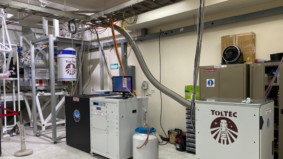
TolTEC installed in the LMT instruments room.
TolTEC is a three-band imaging polarimeter that simultaneously observes at 1.1 mm, 1.4 mm, and 2.0 mm (see Figure 1). The FWHM for its three diffraction limited beams are 5.0, 6.3, and 9.5 arcseconds, respectively. Each band has its own detector array of Lumped Element Kinetic Inductance Detectors (LEKIDs) (see Table 1). Each TolTEC detector is sensitive to a single linear polarization of the incoming light, so each observation of TolTEC results in nine different images of the sky – one in each polarization of each of TolTEC’s three bands along with a total intensity map for each band. The main cryostat containing the arrays and cold optics is made of a series of nested shells connected to a Dilution Refrigerator and Auxiliary Pulse Tube Cooler (AuxPTC), which bring the temperature from 300 K to 4.90 K. The optics bench has a buffer stage at 1.30 K while the arrays themselves are cooled to 0.160 K.
TolTEC was installed in December 2021 and had its first phase of commissioning in July 2022. The second stage of commissioning will begin in the fall of 2022. TolTEC’s high sensitivity and mapping speed will allow for studies covering a wide range of spatial scales and redshifts. Some planned research topics include cosmology and cluster physics, galaxy evolution and the history of star formation in the Universe, relationships between giant molecular clouds and star formation in nearby galaxies, the structure of giant molecular clouds and its relationship to star formation in the Milky Way, and studies of small bodies in our Solar System.
More information on TolTEC, including planned projects and news updates, can be found on the main TolTEC Website. Here is the TolTEC observation planner where you can resolve targets and explore mapping strategies.